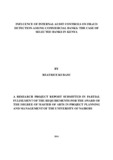| dc.description.abstract | In recent years the importance of good corporate governance has received significant public and regulatory attention. A crucial part of an entity’s corporate governance is its internal audit function. At the same time, there has been significant public concern about the level of fraud within financial institutions. Detecting fraud is a challenging task as perpetrators actively engage in deception in an attempt to conceal their behavior, auditors may have limited experience in fraud detection, and fraudulent activities are inherently unpredictable and difficult to detect.
While financial statement fraud has been the main focus of public interest and research, the other type of fraud that has received less research attention is misappropriation of assets, which is typically perpetrated by employees. In recent past there has been rise in fraudulent cases reported in the banking companies in Kenya leading to placing a number of them such as Charterhouse bank under statutory management by Kenya Bankers Association. Because of the extensive implicit and explicit costs of fraud, identifying ways to increase the probability of fraud detection is of great interest to all stakeholders. This study desires to establish the influence of internal
audit controls on fraud detection among commercial banks. The researcher hopes the study will be of significance to all the existing firms in the banking industry in Kenya as it will give an insight to other aspiring companies on what elements are important for their success.
Government agencies such as KBA and policy makers could use the results to formulate positive national policies. The study could also be invaluable to the Central Bank of Kenya as it could furnish it with information that they may use when coming up with guidelines and regulation governing the commercial banks to ensure fraud reduction. The study provides information to potential and current scholars on the relationship between internal audit controls and fraud
detection among companies in Kenya. This, the researcher hopes will expand their knowledge on internal audit in the banking industry and also identify areas of further study. The study could be a source of reference material for future researchers on other related topics; it could also help other academicians who undertake the same topic in their studies. This research problem was studied through the use of a descriptive survey design. The target population of this study was
the management staff working in commercial banks at the Headquarters in Nairobi. Stratified proportionate random sampling technique was used to select the sample. The study grouped the population into three strata i.e. senior managers, middle level managers and low level managers.
From each stratum the study used purposive sampling to select 120 respondents by taking 20% from each stratum. The study collected both primary and secondary data. Primary data was collected using a questionnaire while secondary data was obtained from annual reports of the companies. Data collected was purely quantitative and it was analyzed by descriptive analysis including the mean, standard deviation, frequencies and percentages. In addition, the researcher conducted a multiple regression analysis so as to determine the effects of each of the five variables on fraud detection. Tables and figures were used to summarize responses for further
analysis and to facilitate comparison. From the findings the study concludes that the five
objectives under study namely; proactive fraud audit; compliance with policies; risk
management; controls over efficiency of operation and management reporting have a positive influence on fraud detection with proportions as indicated by the regression equation; Y=21.58- 0.05X1 – 0.08X2 -0.06 X3 -0.06X4 -0.04X5. This interpreted to mean that a unit increase in any of the independent variables causes a unit increase in fraud detection. The study recommends that the internal audit function in financial institutions should be acknowledged and strengthened as it has a great influence on fraud detection. | en_US |

